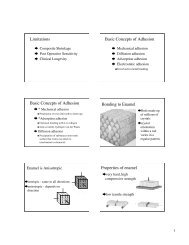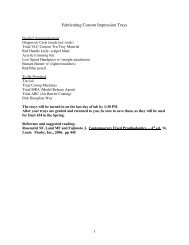Management of the deep carious lesion and the - Ohio State ...
Management of the deep carious lesion and the - Ohio State ...
Management of the deep carious lesion and the - Ohio State ...
Create successful ePaper yourself
Turn your PDF publications into a flip-book with our unique Google optimized e-Paper software.
3A| 2C| 2B| 2A| 1B| 1A|<br />
Deep or partial caries removal: which is best?<br />
In <strong>deep</strong> <strong>carious</strong> <strong>lesion</strong>s, should all infected <strong>and</strong> affected dentine be removed<br />
prior to restoration?<br />
Thompson V, Craig RG, Curro FA, Green WS, Ship JA.<br />
Treatment <strong>of</strong> <strong>deep</strong> <strong>carious</strong> <strong>lesion</strong>s by complete excavation or partial<br />
removal. A critical review. J Am Dent Assoc 2008; 139:705–712<br />
Data sources Searches for studies were made using <strong>the</strong> databases:<br />
Medline, Evidence-based Medicine Reviews, Cochrane Database <strong>of</strong><br />
Systematic Reviews, Cochrane Central Register <strong>of</strong> Controlled Trials <strong>and</strong><br />
OVID’s Database <strong>of</strong> Abstracts <strong>of</strong> Reviews <strong>of</strong> Effects.<br />
Study selection Only studies reported in English with human<br />
participants were included. R<strong>and</strong>omised controlled trials (RCT) <strong>and</strong><br />
relevant observational studies were included. No o<strong>the</strong>r inclusion or<br />
exclusion criteria are described.<br />
Data extraction <strong>and</strong> syn<strong>the</strong>sis A formal data extraction process<br />
is not described <strong>and</strong> a qualitative description <strong>of</strong> <strong>the</strong> included studies<br />
is provided.<br />
Results Ten articles reporting six studies were included. The results <strong>of</strong><br />
three RCT, one with a followup period <strong>of</strong> 10 years, provide evidence supporting<br />
<strong>the</strong> practice <strong>of</strong> leaving behind infected dentine, <strong>the</strong> removal <strong>of</strong><br />
which would risk pulp exposure. A number <strong>of</strong> o<strong>the</strong>r studies show that<br />
cariogenic bacteria, once isolated from <strong>the</strong>ir source <strong>of</strong> nutrition by a<br />
restoration <strong>of</strong> sufficient integrity, ei<strong>the</strong>r remain dormant or die <strong>and</strong> thus<br />
pose no risk to <strong>the</strong> health <strong>of</strong> <strong>the</strong> dentition.<br />
Conclusions There is substantial evidence that, for caries management,<br />
it is not necessary to remove all vestiges <strong>of</strong> infected dentin from<br />
<strong>lesion</strong>s approaching <strong>the</strong> pulp.<br />
Address for correspondence: Dr R Craig, Department <strong>of</strong> Basic Sciences <strong>and</strong><br />
Crani<strong>of</strong>acial Biology, New York University College <strong>of</strong> Dentistry, 345 East 24th<br />
Street/ 1001S, New York NY 10010-4086, USA. E-mail: rgc1@nyu.edu<br />
SUMMARY REVIEW/RESTORATIVE DENTISTRY<br />
Commentary<br />
Since <strong>the</strong> days <strong>of</strong> GV Black, complete caries removal has been<br />
regarded as <strong>the</strong> gold st<strong>and</strong>ard in cavity preparation <strong>and</strong>, despite<br />
<strong>the</strong> lack <strong>of</strong> evidence to support this approach, it remains common<br />
practice today. In <strong>deep</strong> cavities, <strong>the</strong> <strong>carious</strong> process itself <strong>and</strong><br />
<strong>the</strong> trauma <strong>of</strong> such radical caries removal can cause detrimental<br />
inflammatory changes within <strong>the</strong> pulp. If such caries removal<br />
leads to exposure <strong>of</strong> a vital pulp, a direct pulp cap, commonly<br />
using calcium hydroxide, is considered. Although most research<br />
on <strong>the</strong> direct pulp cap has focussed on <strong>the</strong> favourable outcome for<br />
traumatically exposed pulps which are healthy prior to <strong>the</strong> injurious<br />
incident, <strong>the</strong> prognosis following a <strong>carious</strong> exposure is not<br />
good: 5- <strong>and</strong> 10-year success rates <strong>of</strong> 37% <strong>and</strong> 13% respectively<br />
have been reported. 1 This critical review is <strong>the</strong>refore appropriate,<br />
with its systematic search <strong>of</strong> <strong>the</strong> literature for evidence that might<br />
elucidate whe<strong>the</strong>r complete caries removal <strong>and</strong> its concomitant<br />
complications is necessary.<br />
Carefully designed prospective RCT provide <strong>the</strong> strongest evidence<br />
for any intervention. Such trials were <strong>the</strong> focus <strong>of</strong> our 2006 Cochrane<br />
review 2 comparing complete or ultraconservative caries removal. The<br />
authors <strong>of</strong> this paper are correct, however, to draw attention to <strong>the</strong><br />
fact that studies <strong>of</strong> a different design can also add to our underst<strong>and</strong>ing<br />
<strong>and</strong> can <strong>of</strong>ten provide compelling evidence for an intervention.<br />
Not including such studies may be regarded by some as “throwing<br />
<strong>the</strong> baby out with <strong>the</strong> bathwater”. The aim here was <strong>the</strong>refore to<br />
extend <strong>the</strong> search <strong>and</strong> look for additional studies comparing complete<br />
or partial caries removal. In addition to two RCT included in<br />
<strong>the</strong> Cochrane review, four fur<strong>the</strong>r studies were found, specifically<br />
three observational studies <strong>and</strong> one more RCT.<br />
The main aim <strong>of</strong> <strong>the</strong> additional RCT was to investigate <strong>the</strong> cariostatic<br />
effect <strong>of</strong> black copper cement when partial caries removal<br />
was carried out in primary teeth. In <strong>the</strong> partial caries removal group,<br />
<strong>the</strong> durability <strong>of</strong> glass ionomer restorations lined with black copper<br />
cement was poor, but glass ionomer restorations alone performed as<br />
well following partial caries removal as <strong>the</strong>y did following complete<br />
caries removal.<br />
Of <strong>the</strong> three observational studies included here, two were stepwise<br />
excavation in all but name. 3,4 Although o<strong>the</strong>r similar clinical studies<br />
on stepwise excavation were not included in <strong>the</strong> main results <strong>of</strong> this<br />
paper, <strong>the</strong>y were mentioned in <strong>the</strong> text (those cited in <strong>the</strong> Cochrane<br />
review 1 <strong>and</strong> <strong>the</strong> review by Bjørndal <strong>and</strong> Larsen, 2005). Three <strong>of</strong> <strong>the</strong>se<br />
studies showed that caries that is left <strong>and</strong> sealed into <strong>the</strong> tooth after<br />
partial caries removal appears to arrest, so that when <strong>the</strong> cavities<br />
are re-entered <strong>the</strong> number <strong>of</strong> viable organisms within <strong>the</strong> <strong>lesion</strong>s is<br />
significantly reduced. 3–5<br />
The final study included looked at <strong>the</strong> success <strong>of</strong> indirect pulp caps<br />
in primary molar teeth using ei<strong>the</strong>r a calcium hydroxide lining material<br />
or resin-modified glass ionomer. The success rates presented at<br />
4 years were 89% <strong>and</strong> 93%, respectively.<br />
www.nature.com/ebd 71






